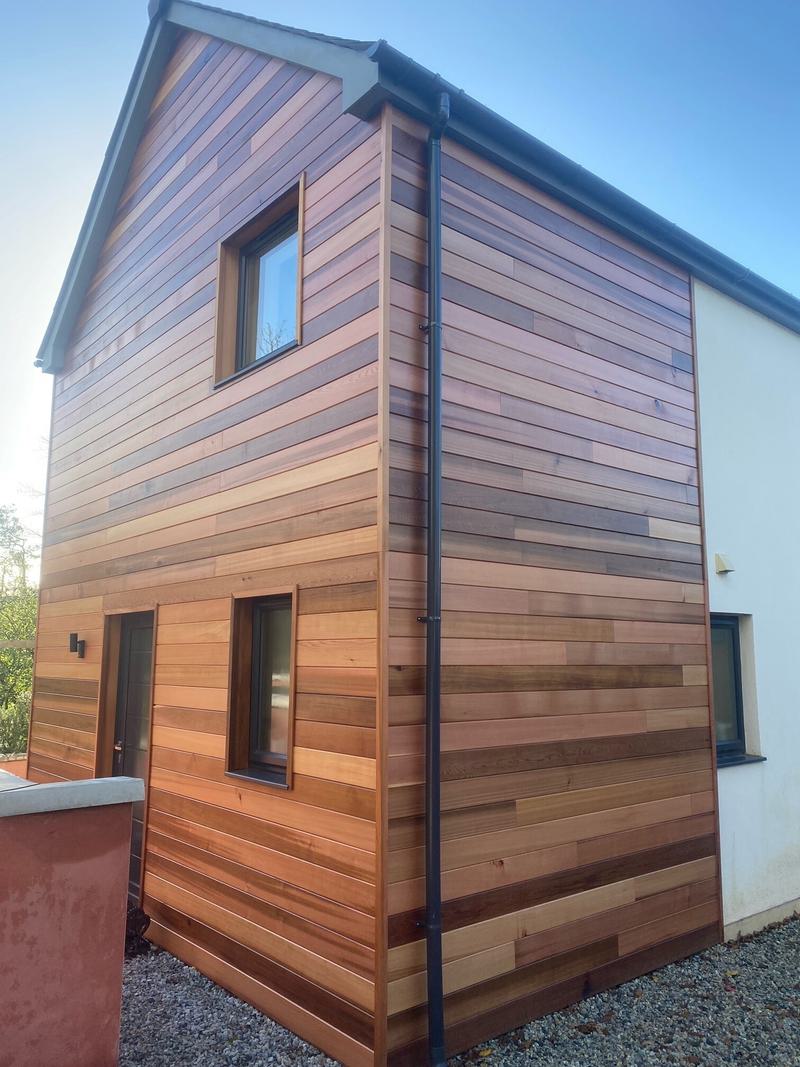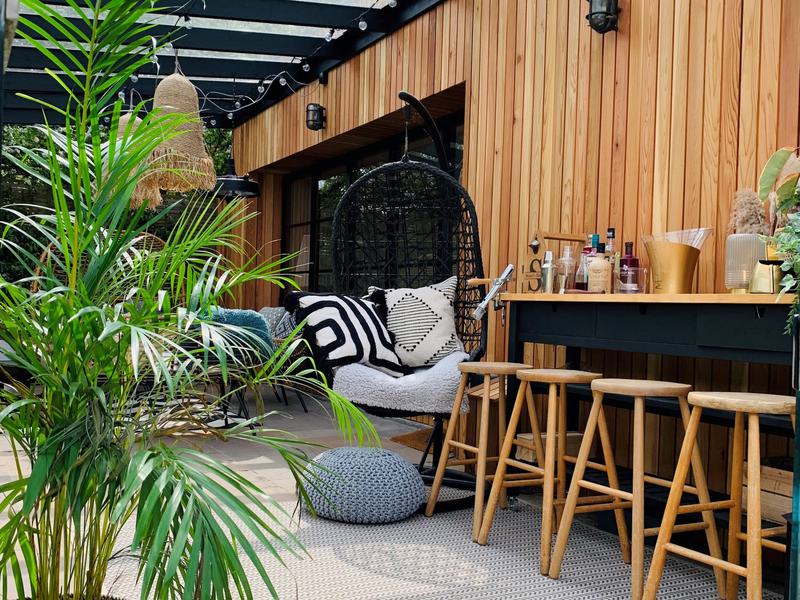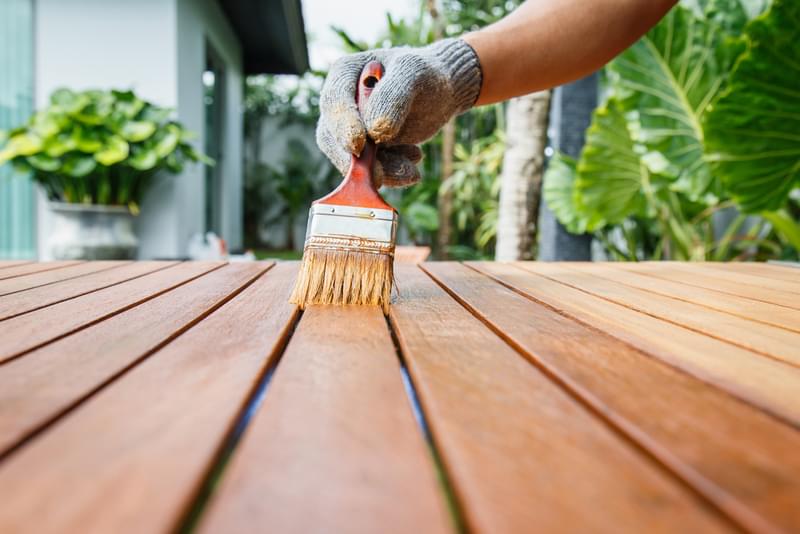Western Red Cedar: The Best Finishes, Treatments and Stains & How to Maintain It
Published on
Cedar is a gorgeous, dynamic and ever-popular choice for cladding, fencing and decking projects.
So, to keep it looking and performing at its best for as long as possible, there’s a few things to know about treatment, finishing and maintenance for this sought-after timber.
Oils, finishes & treatments for Western Red Cedar cladding, fencing & decking
Cedar wood is pitch and resin-free, which means that finishes are held very well by the wood as long as they are applied before the weathering process has begun. Treatments can be broadly placed into these groups: opaque, semi-transparent, transparent or untreated.
Generally, opaque treatments (like paints and solid-colour stains) offer higher protection at the expense of obscuring more of the wood’s natural appearance.
Treatments that are more transparent — like natural stains and water-repellent preservatives — usually offer more modest protection from the elements, but retain a greater amount of the timber’s natural beauty (and can even enhance it).
Top tip — Western Red Cedar has fantastic exterior finish-retention qualities, especially when smooth, as opposed to textured. Therefore, if you’re particularly interested in longevity, look for planed cedar.
1. Opaque or solid-colour
A thorough coating or two of an acrylic-based paint is by far the most protective of the finishes on offer. It will shield the timber from moisture and weathering, but will conceal the wood’s colour and grain to a large extent — so make sure to choose a wood paint of your desired colour.
These are also solid-colour stain finishes, which provide an opaque finish whilst retaining some of the original texture. They offer very strong protection against the elements.
Paints and solid-colour finishes allow you to take full control of appearance, adding a bit of excitement, colour or charm to a finished cedar project — but they’re not for the indecisive!
2. Semi-transparent stains
The best choice, in our opinion. Here, you keep your Western Red Cedar looking its natural beautiful best, whilst keeping it well-protected. A well-chosen semi-transparent finish like this can actually enhance the grain of your cedar.
Semi-transparent stains can provide interesting, subtle changes to the wood’s colour, pronouncing grains and knots — as well as affording great protection. They can be oil-based or natural.
- Oil-based protection penetrates deeper into the wood and usually provide a more drastic change of colour, giving a greater deal of protection from the elements. Owatrol Textrol HES is a good example, providing protection for cedar wood against weather and UV, available in a range of tints from virtually clear to a charcoal.
- Water-based stains like Owatrol Aquadecks (Honey) — will also keep the timber in good condition whilst providing a beautiful finish. They’re seen as more environmentally friendly.
To avoid peeling and flaking further down the line, make the sure product you choose is penetrating and non-film-forming. A good oil or water-based protection typically lasts for 2 years up to first maintenance.


3. Transparent preservative and oils
For a transparent finish with some modest protection, consider a coat of water-repellent preservative, or a bleaching oil. There are a range of products on the market.
Although these don’t provide good UV protection, this sort of red cedar wood preservative will keep the wood’s warm tones for longer and guard against any moisture-related damage like cracking and warping.
Bear in mind that, over time, the cedar will still weather to a grey colour, although this will happen more slowly and you’ll retain the wood’s beautiful, natural tones and patina.
We’d recommend something like Owatrol H4 Wood as an excellent weather protector that doesn't contain any UV filters, allowing the cedar to silver naturally.
Of course, for any finishes applied, make sure to follow the manufacturer’s individual guidelines.

4. Untreated
It’s possible to leave your project without any treatment at all — one of the glories of durable timber species like this. With all its resins, Western Red Cedar is naturally rot resistant and still performs well without a finish.
In fact, grey 'weathered' cedar is actually very much on trend for designers wanting to create a nature-connected space.
When left untreated and exposed to the sun’s oxidising UV light, Western Red Cedar fades and bleaches to a beautiful silvery-grey finish. So if you’re after the weathered cedar look, you simply don’t need to apply any treatment.

If you want the grey cedar look but are keen to guard against splitting and cracking, a natural, water-based preservative (like Owatrol H4 Wood) can be applied. It will still allow the wood to change colour, but more slowly.
Whilst treated cedar cladding still looks great, letting your cedar go grey is actually somewhat of a trend. Amongst architects, there’s been a growing appreciation for leaving materials like timber in their natural, rustic state, with their inherent, untreated beauty on full show.
Less time, effort and expenditure on staining, right? Especially for projects that are especially large or inaccessible… it’s completely possible to just let nature do its thing. This change can happen quite quickly — so even a relatively recently-installed project, you can have some weathered Western Red Cedar cladding on your hands quite soon.
In the UK, the moist climate can cause this weathering process to happen unevenly, so be patient if dark grey patches appear quickly.
If you’re particularly impatient to get your hands on some weathered Western Red Cedar cladding, there are even products which can accelerate this aging process and help cedar go grey!

There’s no right or wrong answer about which is the best treatment for your cedar: your choice will depend on your design preference and required level of protection.
How to treat cedar wood & apply a stain
Once you’ve chosen a treatment (or lack thereof), you’ll need to apply it. Firstly, make sure the timber isn’t wet — this can drastically increase the risk of coating failure.
Another thing that can affect the quality of finish uptake is how weathered the timber is. If your Western Red Cedar is showing signs of age, you’ll have to prepare the wood with a heavy-duty clean and restore. Skip the section below for more details on how to do this.
Applying paint or solid-colour stains
When applying a paint or solid-colour stain, make sure to apply a primer coat before applying the main topcoat. If you’re adding two topcoats, allow the first to cure for the recommended period on the manufacturer’s instructions.
Applying semi-transparent or water-repellent oils
Semi-transparent stains are usually best applied with a brush, although this can be achieved with a roller, pad, spray or drip. A second layer can be added for extra protection, but only if the cedar will accept it.
As with the application of any cedar treatment, we’d always recommend the use of a quality soft brush, if possible — despite usually taking longer, you’ll have a more consistent, even coat.

Restoring & recoating my Western Red Cedar
After a few years, you might notice that your cedar’s finish is wearing slightly thin. At this point, decide if you want it to acquire that natural ‘grey’ aged look, or whether you want to give it a new lick.
If your cedar is still in good condition and isn’t well-weathered, a clean and reapplication will do the trick. To recoat Western Red Cedar, give it a gentle scrub with warm, soapy water to remove dirt and mildew. After the cedar is fully clean and dry, reapply your chosen finish as before.
To restore wood and cladding and recover the original colour of a well-weathered piece of cedar, you’ll need a heavy duty cleaner for your cedar cladding restoration. Owatrol Net-Trol is a powerful wood cleaner that makes cedar cladding, fencing or decking restoration a piece of cake.
Be sure to leave a few days after this preparation to allow the timber to thoroughly dry (and follow any product manufacturer guidelines).
If you’re tired of restoring your wood and find you’re going to undesired lengths to keep the cedar looking good, there’s always the option of buying treated timber.
Duffield Timber: Western Red Cedar products, treatments & more
At Duffield Timber, we are a leading UK stockist and supplier of Western Red Cedar products — cladding, fencing, sawn timber as well as many woodcare finishes.
Whether you’re after a bit more advice on treatments, or you’re looking to kick off a Western Red Cedar project, get in touch with our expert timber team to discuss your needs and requirements.

